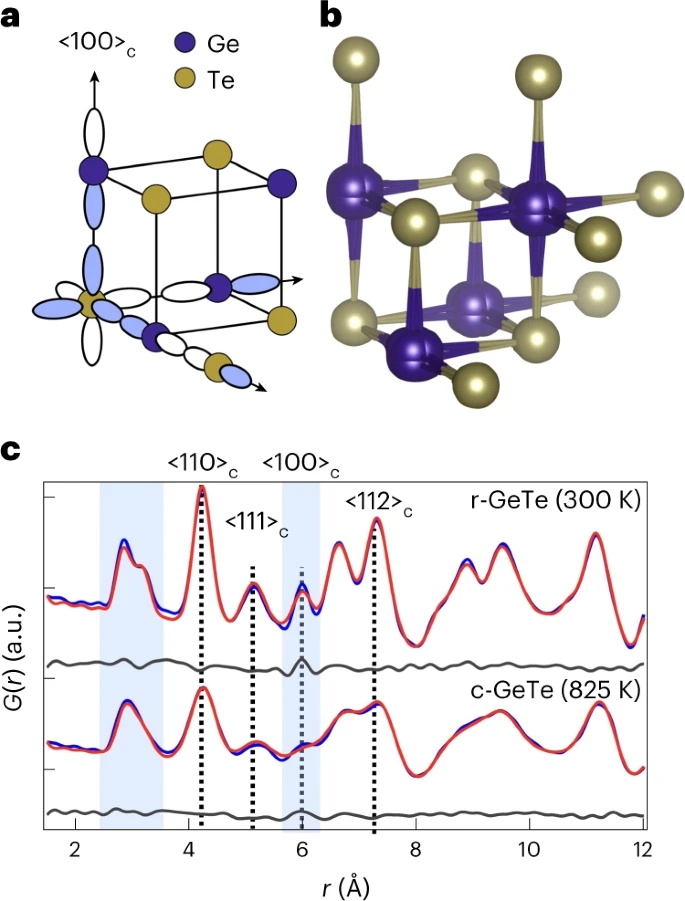博文
拥有皮秒级快门的新型相机,可以看透原子的动态无序状态
||
拥有皮秒级快门的新型相机,可以看透原子的动态无序状态
诸平


据美国哥伦比亚大学工程与应用科学学院(Columbia University School of Engineering and Applied Science)2023年3月7日提供的消息,拥有万亿分之一秒快门的新型相机,可以看透原子的动态无序状态(New 'camera' with shutter speed of 1 trillionth of a second sees through dynamic disorder of atoms)。
研究人员逐渐认识到,在可持续能源应用中表现最好的材料,如将阳光或废热转化为电能,通常是利用更大结构中原子团的集体波动。这个过程通常被称为“动态无序(dynamic disorder)”。在低快门速度下,碲化锗(GeTe)的原子结构看起来有序但模糊。更快的曝光揭示了一个清晰复杂的动态位移模式。相关研究于2023年2月20日已经在《自然材料》(Nature Materials)杂志网站发表——Simon A. J. Kimber, Jiayong Zhang, Charles H. Liang, Gian G. Guzmán-Verri, Peter B. Littlewood, Yongqiang Cheng, Douglas L. Abernathy, Jessica M. Hudspeth, Zhong-Zhen Luo, Mercouri G. Kanatzidis, Tapan Chatterji, Anibal J. Ramirez-Cuesta, Simon J. L. Billinge. Dynamic crystallography reveals spontaneous anisotropy in cubic GeTe. Nature Materials, Published: 20 February 2023. Volume 22, pages 311–315. DOI: 10.1038/s41563-023-01483-7. https://www.nature.com/articles/s41563-023-01483-7
参与此项研究的有来自法国的勃艮第大学(Université Bourgogne Franche-Comté, Université de Bourgogne, Dijon, France)、美国橡树林国家实验室(Oak Ridge National Laboratory, TN, USA)、美国芝加哥大学(University of Chicago, IL, USA)、哥斯达黎加圣何塞市的哥斯达黎加大学(Universidad de Costa Rica, San José, Costa Rica)、美国阿贡国家实验室(Argonne National Laboratory, IL, USA)、法国格勒诺布尔的欧洲同步加速器(The European Synchrotron, Grenoble, France)ESRF、美国埃文斯顿的西北大学(Northwestern University, Evanston, IL, USA)、法国格勒诺布尔的劳-朗之万研究所(Institut Laue-Langevin, Grenoble, France)、美国布鲁克海文国家实验室(Brookhaven National Laboratory, Upton, NY, USA)以及美国纽约的哥伦比亚大学(Columbia University, New York, NY, USA)的研究人员。
动态无序(Dynamic disorder)
了解材料中的动态无序,可以产生更节能的热电设备,如固态冰箱(solid-state refrigerators)和热泵(heat pumps),也可以通过直接将废热转化为电能,更好地回收废热(waste heat),如汽车尾气和发电厂废气。一种热电装置(thermoelectric device)能够从放射性钚(Pu)中吸收热量,并在阳光不足时将其转换为电能,为火星探测器(Mars Rover)提供动力。
当材料在操作设备中运行时,它们的行为就像活生生的在跳舞一样——材料的某些部分会以惊人和意想不到的方式做出反应和改变。这种动态无序性的研究是困难的,因为这些簇不仅是如此的小和无序,而且它们在时间上也是波动的。此外,研究人员对材料中存在的“无聊”非波动性无序现象不感兴趣,因为这种无序现象不会改善性能。直到现在,我们还不可能从相关性较低的静态无序(static disorder)的背景中看到相关的动态无序(dynamic disorder)。
新型“相机”的快门速度快得令人难以置信,约为1皮秒(New "camera" has incredibly fast shutter speed of around 1 picosecond)
哥伦比亚工程学院(Columbia Engineering)和法国勃艮第大学(Université de Bourgogne)的研究人员报告说,他们开发出一种新的“照相机”,可以看到局部的无序。它的主要特点是可变的快门速度:因为无序的原子簇是在移动的,当研究团队使用慢速快门时,动态无序就会变得模糊,但当他们使用快速快门时,他们就能看清。这种新方法被称为可变快门PDF(variable shutter PDF)或简称vsPDF,其中PDF是原子对分布函数(atomic pair distribution function)的简称。与传统相机不同,它使用来自美国能源部橡树岭国家实验室(U.S. Department of Energy's Oak Ridge National Laboratory, ORNL)的中子来测量原子快门速度约为1皮秒(1 ps),比普通相机快万亿倍。
材料科学(materials science)、应用物理和应用数学(applied physics and applied mathematics)教授西蒙·比林格(Simon Billinge)说:“只有使用这个新的vsPDF工具,我们才能真正看到材料的这一面。它为我们提供了一种全新的方式来解决复杂材料中的复杂问题,这些隐藏的效应会增强材料的特性。通过这项技术,我们可以观察物质,知道哪些原子在跳舞,哪些原子在外面。美国橡树林国家实验室对于“用中子摄影机揭示原子结构”有专门的视频,请注意点击浏览(Revealing Atomic Structures with a "Neutron" Camera. Credit: Oak Ridge National Laboratory)。
稳定局部波动和将余热转化为电能的新理论(New theory on stabilizing local fluctuations and converting waste heat to electricity)
研究人员利用vsPDF工具发现GeTe中的原子对称性正在被打破,GeTe是一种将废热转化为电能(或电能转化为冷却)的重要热电材料。他们以前无法看到位移,也无法显示动态波动(dynamic fluctuations)和波动的速度。基于vsPDF的洞察,该团队开发了一种新理论,该理论揭示了这种局部波动如何在GeTe和相关材料中形成。这种对舞蹈的机械理解将有助于研究人员寻找具有这些效果的新材料,并应用外力来影响效果,从而产生更好的材料。
研究小组(Research team)
西蒙·比林格的研究小组与西蒙·金伯(Simon Kimber)共同领导了这项工作,西蒙·金伯在进行这项研究时就读于法国勃艮第大学。西蒙·比林格和西蒙·金伯与橡树林国家实验室(ORNL)和同样由能源部资助的阿贡国家实验室(ANL)的同事一起工作。在ORNL进行了vsPDF相机的非弹性中子散射测量;在ANL进行了理论测量。
下一步(Next steps)
西蒙·比林格正在致力于使他的技术更易于在研究界中使用,并将其应用到其他动态无序的系统中。目前,这项技术还不是一次性的,但随着进一步的发展,它应该会成为一种更加标准的测量手段,可以用于许多对原子动力学非常重要的材料系统,从观察锂在电池电极中的运动到研究阳光下水分裂的动态过程。
本研究得到了美国能源部科学办公室基础能源科学办公室(US DOE, Office of Science, Office of Basic Energy Sciences, under contract no. DE- SC0012704,under award no. DE-SC0014520;US DOE, Office of Science, Office of Basic Energy Sciences, Materials Sciences and Engineering, under contract no. DE-AC02-06CH11357)、美国国家科学基金会(NSF GRFP DGE-1746045)、哥斯达黎加国立大学(University of Costa Rica project no. 816-C1-601)以及未来投资计划(ISITE-BFC project contract no. ANR-15-IDEX-0003)的支持和资助。
上述介绍,仅供参考。欲了解更多信息,敬请注意浏览原文或者相关报道。
Cubic energy materials such as thermoelectrics or hybrid perovskite materials are often understood to be highly disordered1,2. In GeTe and related IV–VI compounds, this is thought to provide the low thermal conductivities needed for thermoelectric applications1. Since conventional crystallography cannot distinguish between static disorder and atomic motions, we develop the energy-resolved variable-shutter pair distribution function technique. This collects structural snapshots with varying exposure times, on timescales relevant for atomic motions. In disagreement with previous interpretations3,4,5, we find the time-averaged structure of GeTe to be crystalline at all temperatures, but with anisotropic anharmonic dynamics at higher temperatures that resemble static disorder at fast shutter speeds, with correlated ferroelectric fluctuations along the <100>c direction. We show that this anisotropy naturally emerges from a Ginzburg–Landau model that couples polarization fluctuations through long-range elastic interactions6. By accessing time-dependent atomic correlations in energy materials, we resolve the long-standing disagreement between local and average structure probes1,7,8,9 and show that spontaneous anisotropy is ubiquitous in cubic IV–VI materials.
https://blog.sciencenet.cn/blog-212210-1379819.html
上一篇:纳米塑料如何影响新陈代谢
下一篇:大连化物所研究人员揭开合成气催化转化新平台